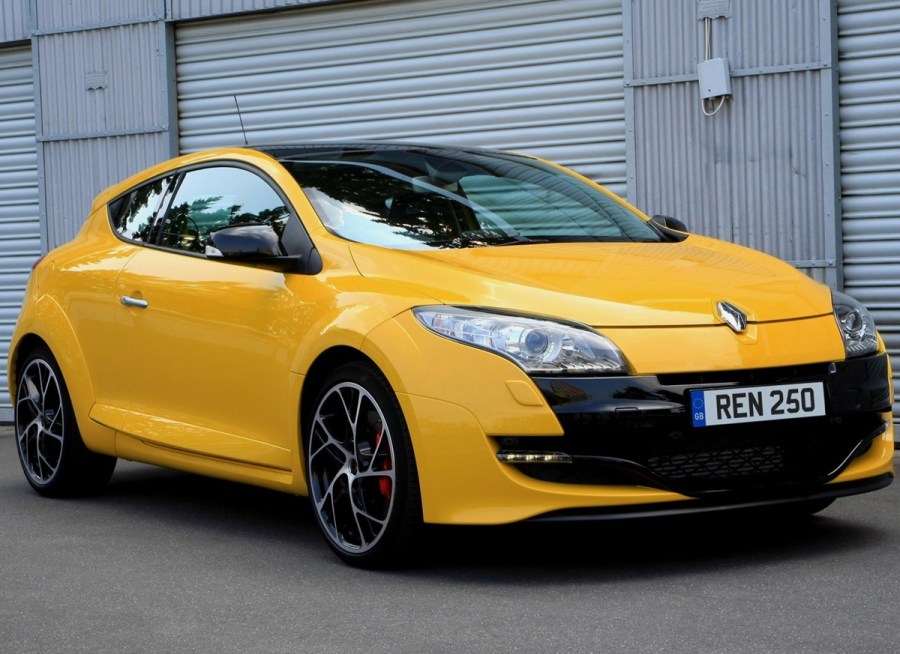Hot on the heels of its hardcore bustlebacked predecessor, the R26R, the Megane RS250 may offer greater comfort and more mainstream looks, but its performance is just as electrifying. This Renault Megane RS250 tuning guide will explain how to make it even more thrilling.
Sporty Megane history
Renault’s mid-sized hatchback first received the hot hatch treatment in 2004, when the French firm released the Renault Sport Megane 225. Although the second generation bodyshells on which the model was based were built in Spain, the first spicy Meganes were actually assembled exclusively in Dieppe, the traditional home of performance Renaults. The spec included a turbocharged version of the Clio 172s 2.0-litre lump running through a short-shifting six-speed gearbox to drive the front wheels. The angular lines and prominent rump made for a challenging aesthetic, but the searing performance was enough for petrolheads to overlook the styling and revel in the 225bhp output, which was capable of rocketing the hatch to a 0-60mph time of 6.5 seconds and on to a 149mph top speed.
The base model was succeeded by various derivatives such as the lighter and stiffer Cup model in 2005 and the 227bhp 230 Renault F1 Team R26 in 2006 – a model that celebrated Renault’s 2005 Constructors’ and Drivers’ Championship Formula 1 titles. The pick of the bunch, however, was undoubtedly the hardcore R26.R model of 2009, which boasted a polycarbonate tailgate and windows, carbon bonnet, six point harnesses, a rollcage and deleted rear seats. This lightweight wonder went on to secure the then-record Nordschleife lap time of 8m17s.
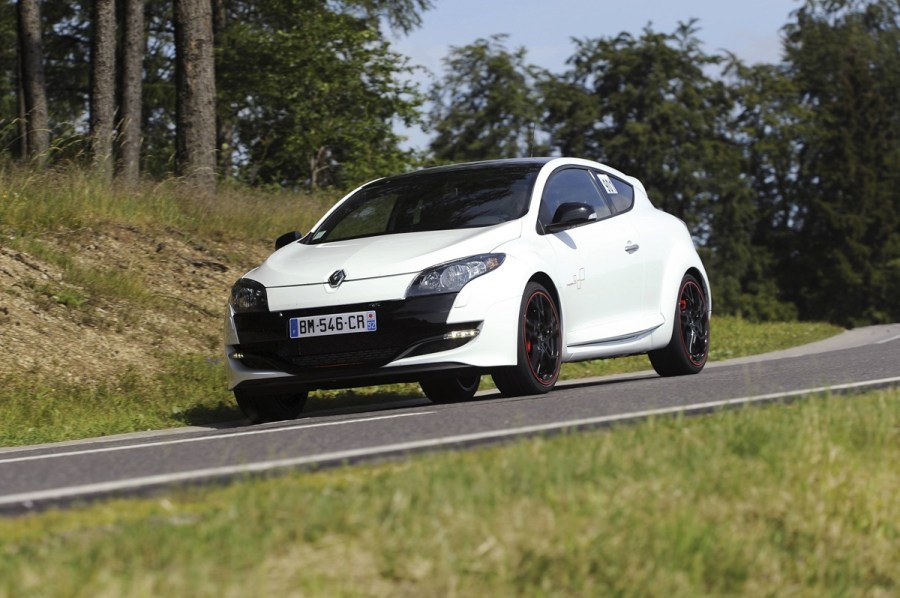
The arrival of the RS 250
This performance pedigree meant that in 2010, Renault Sport had a tough act to follow with the next generation of RS Meganes. Now based on the gen-three Megane hatch, the new model, dubbed the RS 250, was built solely in Spain and utilized the comically-acronymmed F4Rt engine stuffed into a body-kitted three-door shell.
Again, a six-speed manual threw all of the 247bhp to the front wheels where trick, torque-steer reducing Perfohub struts and a limited slip differential meant it could use all of it effectively. Combined with a torsion beam rear end, handling was scalpel sharp while the crackle from the centrally-mounted exhaust system added aural delight to downshifts.
Special editions
Like its predecessor, a hotter – and remarkably cheaper – Cup variant added lightness and stiffness as well as a mechanical LSD to improve grip, while a 265 Trophy model upped the power to 261bhp and added unique 19in alloys with sticky Potenza RE05a tyres and Recaro seats into the mix. A Red Bull Racing RB8 model sounded good on paper, but was more of a styling exercise in reality, which is not something that could be said for the RS275 Trophy-R and RS275 Cup-S models that were unveiled towards the end of the second-gen Megane RS’s production run. These added even more power with less creature comforts and the most track focused handling yet.
So, while it’s clear that the RS 250 generation Meganes are seriously potent machines from the factory, there’s still plenty you can do from a tuning perspective to extract even greater levels of performance from these flying Frenchies.
To help you choose the right route to tuning your RS 250, we’ve broken down the car into its component parts to give you specific advice on how to maximise each area. We’ll show the essential areas to spend your cash to turn your Megane into a monster!
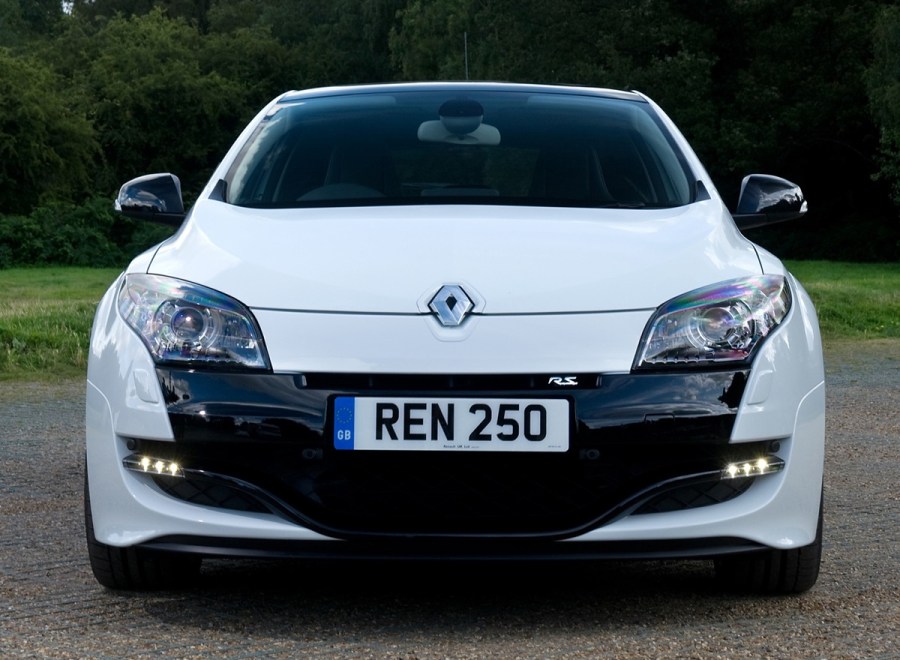
Megane RS 250 engine tuning
The Megane’s turbocharged 2.0-litre four-cylinder F4Rt motor may sound like a joke, but it’s a seriously capable power plant, one that benefits from being relatively unstressed and makes power smoothly and with ease. This means it has plenty of scope for tuning while remaining extremely reliable. Around 300bhp is achievable with very little cost, but you must remember to uprate the cooling system too, or risk overheating issues arising in heavy traffic, or when using the car hard on track.
Intake Tuning
The Megane 250/265’s standard airbox flows well and resists heat soak at standardish levels of tune, but can be found lacking when the power levels have been pushed up by a re-map and other modifications. To get the most from your Megane, an upgrade to a freer-flowing panel filter element can be added to the standard airbox. These cost around £35 and are super easy to install. When combined with a dedicated cold air feed pipe from the front bumper to the airbox, it can make noticeable gains, however an induction kit from the likes of ITG can release even more pent up ponies.
Intake kits that use custom pipe work to relocate a cone filter down in the front bumper, well away from any power-robbing under-bonnet heat, are reported to shown gains of up to 10bhp. Aside from the increase in power, there are also improvements to the throttle response as well as a more aggressive intake noise.
Exhaust Tuning
As with any turbocharged car, big performance gains can be made on the Megane RS 250 by upgrading the stock exhaust system to a larger bore, freer flowing unit. The bulk of the stock system’s restriction lies in the OEM downpipe and catalyst, so swapping this for a larger 3in bore system will produce noticeable gains of around 10bhp in peak power and reduced turbo spool up times. These are available for around £240 for a straight through pipe, or around £635 with a 200 cell sports catalyst, which will be necessary of the car is to meet MOT emissions regulations.
While not strictly essential, an ECU remap is often recommended when fitting a larger aftermarket downpipe, although it might be worth holding off until you fit an accompanying cat-back exhaust system too. A full 3in cat-back system is recommended for the RS 250 ideally made from 304 stainless steel for a long service life and light weight. Look for systems that include centre silencers if you are hoping to go on track, as these can help keep exhaust noise down in order to pass strict circuit noise regulations. Most decent cat-back systems are dyno proven to release around 8-10bhp and up to 16lb ft of torque over the stock set up, so are well worthwhile. Cars that have both downpipe and exhaust as well as a suitable remap can expect even bigger gains.
Engine ECU Remapping
Although practically all engines will see performance gains from ECU remapping, turbocharged engines such as the Megane’s F4Rt engine are especially suitable, but you must ensure you use a reputable company that knows what they are doing, and ideally opt for a custom service that is calibrated on a rolling road to your car’s specific modifications and not just a generic reflash.
Custom ECU tuning such as this is available for all models of the second-gen RS Megane (including later cars with the Euro 6 EMS3125 ECU) on the original factory-fitted ECU.
The OEM ECU is quite versatile and can be tuned to cater for most performance modifications including air filter and exhaust changes, right through to hybrid turbos, gas flowed cylinder heads, larger injectors and forged engine builds.
Many tuners break down their remapping into levels or stages. Stage one being for standard base engine with bolt-on supporting modifications such as air filters, cat-back exhaust systems and intercoolers (which often takes power up to around 300-320bhp), while stage two adds de-cat or sports cat pipes (310-340bhp) and stage three throws in hybrid turbos, larger fuel injectors, fuel system modifications and performance camshafts (350-400bhp+).
The cost of mapping varies between tuners but most are around £395 for a custom tune on a dyno.
Cooling upgrades
The Megane RS 250’s stock intercooler is relatively small, which not only reduces if effectiveness for cooling the intake charge, but also presents a restriction to air flow when boost levels are increased through tuning. The answer is to fit one of the many aftermarket front-mount intercoolers, such as those from Airtec. These come in stage one and stage two varieties and are both designed to fit neatly behind the original bumper, with no trimming or cutting and can even be used with the original hoses. The stage one cooler is smaller and features a 60mm core with cast end tanks and will easily cope with between 300-450bhp. The stage two offering has the same core thickness but is a much taller design for even better cooling and flow which has been shown to gain an extra 36bhp and 38lb ft over the OEM setup.
Fueling
The RS 250’s standard fuel system can supply enough juice for around 310bhp, however, go much beyond this point and the injectors will be maxed out and struggling. The answer is to upgrade the squirters to a set of larger units such as Deka 630cc items which should be good for around 400bhp. Breaching this lofty limit you can go to Deka 875cc items or even some big daddy Bosch 980cc units. Obviously these beefier injectors can only inject what they are supplied, so an upgrade of the standard fuel pump to an uprated 255lph drop-in one from the likes of Walbro or Sytec is necessary for maximum gains.
Turbo
The standard turbocharger that is bolted to the Megane’s F4Rt engine is good for around 320bhp, above which it soon runs out of puff. To go beyond this level, an upgrade to a hybrid 20T turbo is required, which uses a larger 20T billet compressor wheel, a TD04L large trim turbine wheel and a motorsport-spec 360 degree thrust bearing. With the right supporting mods to fueling and breathing, this bigger blower will be good for 350bhp with around 400lb ft of torque, although you are warned that this will likely be too much for the standard internals, meaning a rebuild with forged pistons and rods is advised before going for this turbo upgrade.
If you still crave more power and have forged the engine, then a Garrett turbo kit is the next step. Using a Garrett GTX2867R turbo the kit includes a new downpipe with external wastegate and can liberate over 400bhp with ease while still retaining excellent response.
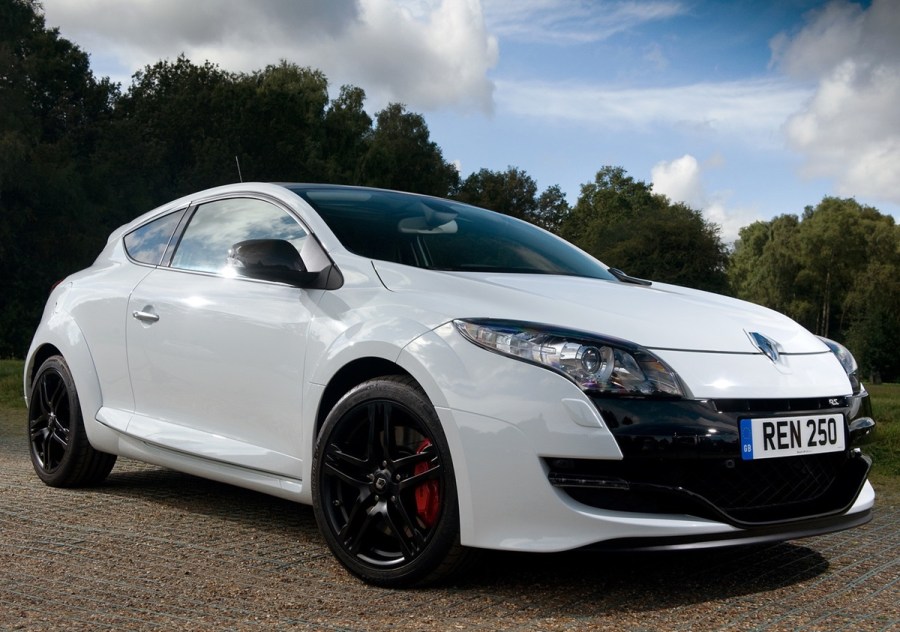
Megane RS 250 transmission upgrades
The RS 250’s transmission can handle some serious hikes in horsepower without too much hassle, with many owners reporting having no issues with the stock clutch right up to 400bhp. However, the dual mass flywheel does have its issues, and is currently a nightmare to get hold of a stock replacement, so many owners are making the switch to a single mass lightweight item. Combined with an uprated RTS semi organic clutch, it should basically bulletproof the RS 250s transmission. Gaining extra grip through the bends can be achieved by swapping the factory limited slip differential to a more aggressive Gripper LSD. These are a plate type LSD that cost around £1500 but will transform the way the car handles.
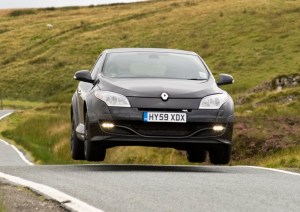
Megane RS 250 suspension tuning
French hot hatches have been writing the rule book on handling since the ‘80s, and the Renault Sport Megane is no exception. It may only be front wheel drive, but it’s trick front hubs and fixed rear beam work beautifully together to produce sublime cornering ability that defies the laws of physics.
Springs and dampers
As we’ve already mentioned, the RS 250 has stellar suspension straight out of the box that works well on most roads and surfaces, but push it hard on track and it can be left wanting. Those on a budget that want to improve the cars looks with a subtle drop and add a mild improvement in handling can simply switch out the standard springs for some lowered and uprated items from the likes of Cooksport, H&R or Eibach. Stepping things up further would be to upgrade the dampers too, which can be done as a kit with matched lowered springs in the form of Bilstein’s B12 kit.
The final word in fully adjustable track-ready suspension however, has got to be coilovers, and these range from around £1050 for a set of BR Series BC Racing coilovers to just under £4000 for Bilstein’s B16 Clubsport kit. Those with even deeper pockets can opt for Nitron’s NTR R3 kit which retails from £5340. Remember to ensure an accurate four-wheel alignment has been carried out by a specialist after any suspension tweaks.
Bushes
With early cars now just shy of 15 years old, it’s a wise move to look at the Megane’s OEM rubber bushes. Many will have signs of perishing, or if not can still be improved upon with a set of firmer polyurethane items from the likes of Powerflex or Superpro. These not only improve the car’s handling, but they also reduce tyre wear and improve the feel in your steering, due to having less ‘give’ than the standard bushes. Simply fit and forget, but revel in the improvement in your car’s cornering. Powerflex’s Megane RS handling pack includes upgraded bushes for both front and rear arms and costs £330 without fitting.
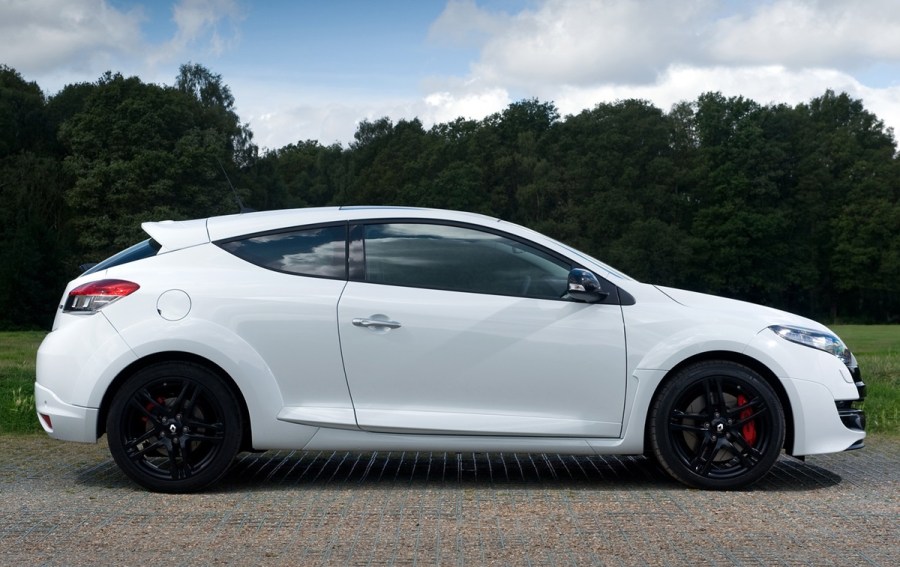
Megane RS 250 brakes, wheels & tyres
As standard, the RS 250 comes with 340mm discs with meaty four-pot Brembo calipers up front which, on the road, is a stonkingly effective setup. However, on the track, things can get a little heated and performance starts to fade. To halt this drop-off in effectiveness, it’s recommended to upgrade the front discs to a pair of two-piece floating rotors for the track or fixed items for the road (due to noise), and swap out the OEM pads (both front and rear) for some uprated items from either Carbon Lorraine, EBC, Pagid or Ferodo. A set of braided brakes hoses and uprated DOT4 fluid will also help bite and produce a firmer pedal feel. Beyond this a full big brake kit from the likes of TarOx, K-Sport or Alcon is available, but unless you intend on using the car for competition purposes, then they are largely unnecessary.
performance wheels and tyres
The RS 250 was offered with 8x18in or (optional) 8x19in wheels as standard, with Michelin Pilot Sport 2 and Continental CSC5 tyres respectively. These look OK, and work well with the factory suspension, but many track day enthusiasts prefer to drop down to a 17in rim with a fatter tyre profile, often opting for a semi-slick tyre such as Nankang’s AR1 or Toyos R888R.
If you do decide to replace the standard wheels, try and ensure you look for replacement wheels that are as light as you can realistically afford, this is because heavy wheels increase the amount of unsprung mass, which will dampen all the good work you have done with your suspension, engine and braking upgrades. Lightweight options that will fit straight on include the OZ Ultraleggera, the Evo Corse and the Sparco Pro Corsa.
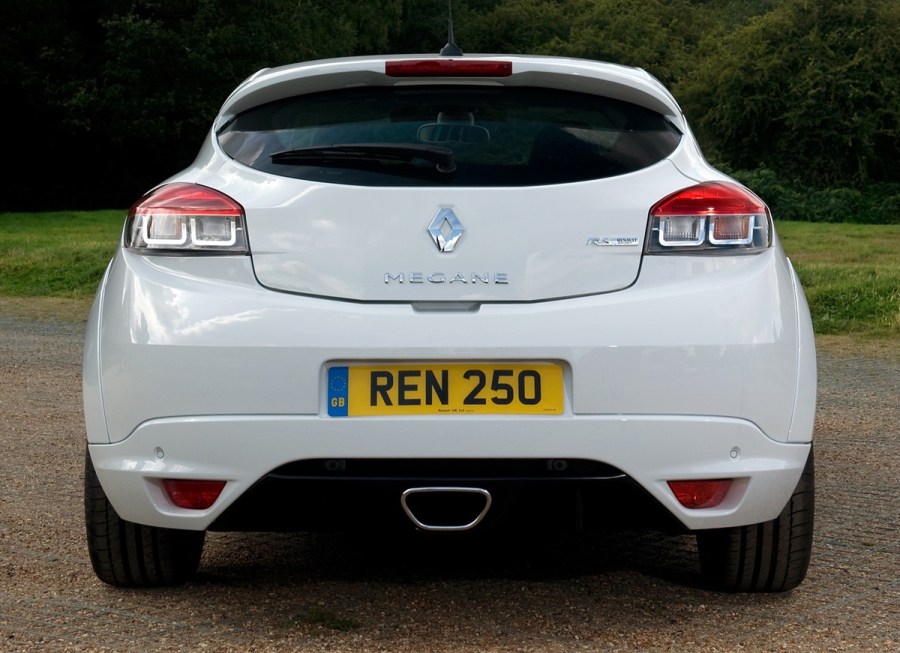
Interior upgrades
French hot hatches are all about the white knuckle ride, and tend to leave the tech and lavish leather trim to their German rivals. But that’s fine with us, as it means you can go to town to give your Megane some track chic in the interior department without fear of losing too many luxuries. Some RS models came with optional Recaro CS seats, which we would leave as they are, but the standard seats would be better swapped for some Recaro Pole Positions or Motormec buckets. These work perfectly with a set of harnesses and will hold you in place firmly when putting the improved handling through its paces on road or track.
Some owners have also stripped out the rear seat and added a half rollcage to build their own version of the previous R26.R, which is great, as long as you don’t need rear seats. Other mods such as race steering wheels and gearknobs can also heighten the driving experience.
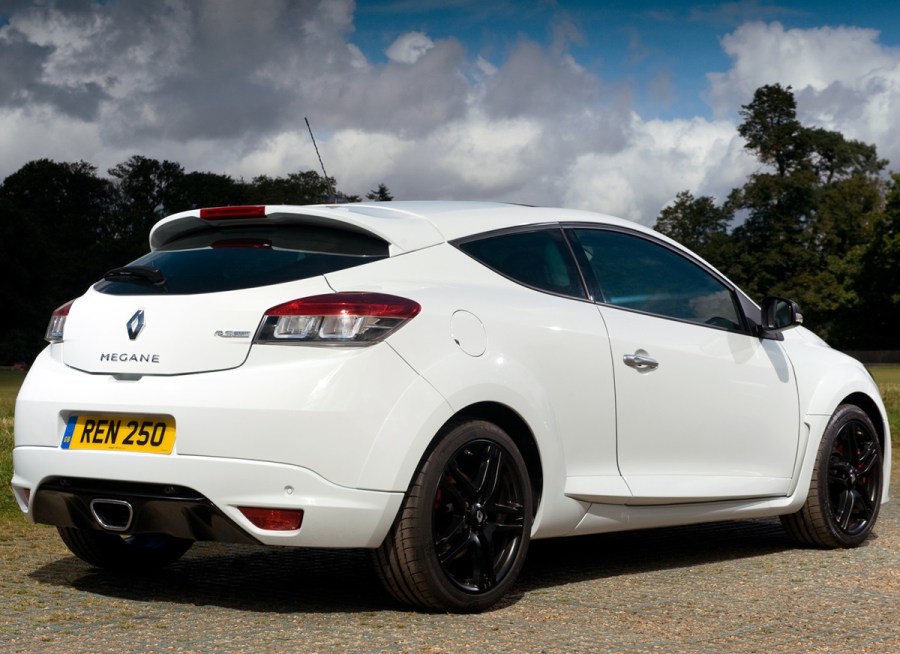
Styling upgrades
Much like the interior, the way to go with Megane RS styling is to keep things circuit inspired. Maxton Design produce a range of products for the RS such as deeper front splitters, side skirt extensions and diffusers all help the car’s aerodynamics, while a larger Cup-style rear spoiler adds an aggressive motorsport edge. For the really committed, a funky race inspired wrap of an iconic livery would be the icing on the cake!
Words by Dan Sherwood.

